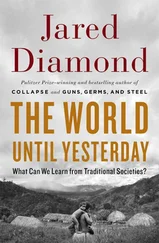Jared Diamond - Guns, Germs & Steel
Здесь есть возможность читать онлайн «Jared Diamond - Guns, Germs & Steel» весь текст электронной книги совершенно бесплатно (целиком полную версию без сокращений). В некоторых случаях можно слушать аудио, скачать через торрент в формате fb2 и присутствует краткое содержание. Жанр: 105. Описание произведения, (предисловие) а так же отзывы посетителей доступны на портале библиотеки ЛибКат.
- Название:Guns, Germs & Steel
- Автор:
- Жанр:
- Год:неизвестен
- ISBN:нет данных
- Рейтинг книги:5 / 5. Голосов: 1
-
Избранное:Добавить в избранное
- Отзывы:
-
Ваша оценка:
- 100
- 1
- 2
- 3
- 4
- 5
Guns, Germs & Steel: краткое содержание, описание и аннотация
Предлагаем к чтению аннотацию, описание, краткое содержание или предисловие (зависит от того, что написал сам автор книги «Guns, Germs & Steel»). Если вы не нашли необходимую информацию о книге — напишите в комментариях, мы постараемся отыскать её.
Guns, Germs & Steel — читать онлайн бесплатно полную книгу (весь текст) целиком
Ниже представлен текст книги, разбитый по страницам. Система сохранения места последней прочитанной страницы, позволяет с удобством читать онлайн бесплатно книгу «Guns, Germs & Steel», без необходимости каждый раз заново искать на чём Вы остановились. Поставьте закладку, и сможете в любой момент перейти на страницу, на которой закончили чтение.
Интервал:
Закладка:
YALI'S PEOPLE • 311
was reaped with stone knives, piled into haystacks, and threshed to obtain the seeds, which were then stored in skin bags or wooden dishes and finally ground with millstones. Several of the tools used in this process, such as the stone reaping knives and grindstones, were similar to the tools independently invented in the Fertile Crescent for processing seeds of other wild grasses. Of all the food-acquiring methods of Aboriginal Australians, millet harvesting is perhaps the one most likely to have evolved eventually into crop production.
Along with intensified food gathering in the last 5,000 years came new types of tools. Small stone blades and points provided more length of sharp edge per pound of tool than the large stone tools they replaced. Hatchets with ground stone edges, once present only locally in Australia, became widespread. Shell fishhooks appeared within the last thousand years.
why did australia not develop metal tools, writing, and politically complex societies? A major reason is that Aborigines remained hunter-gatherers, whereas, as we saw in Chapters 12-14, those developments arose elsewhere only in populous and economically specialized societies of food producers. In addition, Australia's aridity, infertility, and climatic unpredictability limited its hunter-gatherer population to only a few hundred thousand people. Compared with the tens of millions of people in ancient China or Mesoamerica, that meant that Australia had far fewer potential inventors, and far fewer societies to experiment with adopting innovations. Nor were its several hundred thousand people organized into closely interacting societies. Aboriginal Australia instead consisted of a sea of very sparsely populated desert separating several more productive ecological "islands," each of them holding only a fraction of the continent's population and with interactions attenuated by the intervening distance. Even within the relatively moist and productive eastern side of the continent, exchanges between societies were limited by the 1,900 miles from Queensland's tropical rain forests in the northeast to Victoria's temperate rain forests in the southeast, a geographic and ecological distance as great as that from Los Angeles to Alaska.
Some apparent regional or continentwide regressions of technology in Australia may stem from the isolation and relatively few inhabitants of its population centers. The boomerang, that quintessential Australian
312 • GUNS, GERMS, AND STEEL
weapon, was abandoned in the Cape York Peninsula of northeastern Australia. When encountered by Europeans, the Aborigines of southwestern Australia did not eat shellfish. The function of the small stone points that appear in Australian archaeological sites around 5,000 years ago remains uncertain: while an easy explanation is that they may have been used as spearpoints and barbs, they are suspiciously similar to the stone points and barbs used on arrows elsewhere in the world. If they really were so used, the mystery of bows and arrows being present in modern New Guinea but absent in Australia might be compounded: perhaps bows and arrows actually were adopted for a while, then abandoned, across the Australian continent. All these examples remind us of the abandonment of guns in Japan, of bows and arrows and pottery in most of Polynesia, and of other technologies in other isolated societies (Chapter 13).
The most extreme losses of technology in the Australian region took place on the island of Tasmania, 130 miles off the coast of southeastern Australia. At Pleistocene times of low sea level, the shallow Bass Strait now separating Tasmania from Australia was dry land, and the people occupying Tasmania were part of the human population distributed continuously over an expanded Australian continent. When the strait was at last flooded around 10,000 years ago, Tasmanians and mainland Australians became cut off from each other because neither group possessed watercraft capable of negotiating Bass Strait. Thereafter, Tasmania's population of 4,000 hunter-gatherers remained out of contact with all other humans on Earth, living in an isolation otherwise known only from science fiction novels.
When finally encountered by Europeans in a.d. 1642, the Tasmanians had the simplest material culture of any people in the modern world. Like mainland Aborigines, they were hunter-gatherers without metal tools. But they also lacked many technologies and artifacts widespread on the mainland, including barbed spears, bone tools of any type, boomerangs, ground or polished stone tools, hafted stone tools, hooks, nets, pronged spears, traps, and the practices of catching and eating fish, sewing, and starting a fire. Some of these technologies may have arrived or been invented in mainland Australia only after Tasmania became isolated, in which case we can conclude that the tiny Tasmanian population did not independently invent these technologies for itself. Others of these technologies were brought to Tasmania when it was still part of the Australian mainland, and were subsequently lost in Tasmania's cultural isolation. For example,
YALI'S PEOPLE • 313
the Tasmanian archaeological record documents the disappearance of fishing, and of awls, needles, and other bone tools, around 1500 b.c. On at least three smaller islands (Flinders, Kangaroo, and King) that were isolated from Australia or Tasmania by rising sea levels around 10,000 years ago, human populations that would initially have numbered around 200 to 400 died out completely.
Tasmania and those three smaller islands thus illustrate in extreme form a conclusion of broad potential significance for world history. Human populations of only a few hundred people were unable to survive indefinitely in complete isolation. A population of 4,000 was able to survive for 10,000 years, but with significant cultural losses and significant failures to invent, leaving it with a uniquely simplified material culture. Mainland Australia's 300,000 hunter-gatherers were more numerous and less isolated than the Tasmanians but still constituted the smallest and most isolated human population of any of the continents. The documented instances of technological regression on the Australian mainland, and the example of Tasmania, suggest that the limited repertoire of Native Australians compared with that of peoples of other continents may stem in part from the effects of isolation and population size on the development and maintenance of technology—like those effects on Tasmania, but less extreme. By implication, the same effects may have contributed to differences in technology between the largest continent (Eurasia) and the next smaller ones (Africa, North America, and South America).
why didn't mo re-advanced technology reach Australia from its neighbors, Indonesia and New Guinea? As regards Indonesia, it was separated from northwestern Australia by water and was very different from it ecologically. In addition, Indonesia itself was a cultural and technological backwater until a few thousand years ago. There is no evidence of any new technology or introduction reaching Australia from Indonesia, after Australia's initial colonization 40,000 years ago, until the dingo appeared around 1500 b.c.
The dingo reached Australia at the peak of the Austronesian expansion from South China through Indonesia. Austronesians succeeded in settling all the islands of Indonesia, including the two closest to Australia—Timor and Tanimbar (only 275 and 205 miles from modern Australia, respectively). Since Austronesians covered far greater sea distances in the course
314 " GUNS, GERMS, AND STEEL
of their expansion across the Pacific, we would have to assume that they repeatedly reached Australia, even if we did not have the evidence of the dingo to prove it. In historical times northwestern Australia was visited each year by sailing canoes from the Macassar district on the Indonesian island of Sulawesi (Celebes), until the Australian government stopped the visits in 1907. Archaeological evidence traces the visits back until around a.d. 1000, and they may well have been going on earlier. The main purpose of the visits was to obtain sea cucumbers (also known as beche-de-mer or trepang), starfish relatives exported from Macassar to China as a reputed aphrodisiac and prized ingredient of soups.
Naturally, the trade that developed during the Macassans' annual visits left many legacies in northwestern Australia. The Macassans planted tamarind trees at their coastal campsites and sired children by Aboriginal women. Cloth, metal tools, pottery, and glass were brought as trade goods, though Aborigines never learned to manufacture those items themselves. Aborigines did acquire from the Macassans some loan words, some ceremonies, and the practices of using dugout sailing canoes and smoking tobacco in pipes.
But none of these influences altered the basic character of Australian society. More important than what happened as a result of the Macassan visits is what did not happen. The Macassans did not settle in Australia— undoubtedly because the area of northwestern Australia facing Indonesia is much too dry for Macassan agriculture. Had Indonesia faced the tropical rain forests and savannas of northeastern Australia, the Macassans could have settled, but there is no evidence that they ever traveled that far. Since the Macassans thus came only in small numbers and for temporary visits and never penetrated inland, just a few groups of Australians on a small stretch of coast were exposed to them. Even those few Australians got to see only a fraction of Macassan culture and technology, rather than a full Macassan society with rice fields, pigs, villages, and workshops. Because the Australians remained nomadic hunter-gatherers, they acquired only those few Macassan products and practices compatible with their lifestyle. Dugout sailing canoes and pipes, yes; forges and pigs, no.
Apparently much more astonishing than Australians' resistance to Indonesian influence is their resistance to New Guinea influence. Across the narrow ribbon of water known as Torres Strait, New Guinea farmers who spoke New Guinea languages and had pigs, pottery, and bows and arrows faced Australian hunter-gatherers who spoke Australian languages and
Интервал:
Закладка:
Похожие книги на «Guns, Germs & Steel»
Представляем Вашему вниманию похожие книги на «Guns, Germs & Steel» списком для выбора. Мы отобрали схожую по названию и смыслу литературу в надежде предоставить читателям больше вариантов отыскать новые, интересные, ещё непрочитанные произведения.
Обсуждение, отзывы о книге «Guns, Germs & Steel» и просто собственные мнения читателей. Оставьте ваши комментарии, напишите, что Вы думаете о произведении, его смысле или главных героях. Укажите что конкретно понравилось, а что нет, и почему Вы так считаете.










